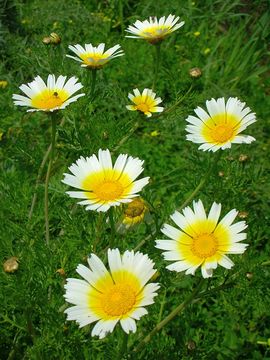Glebionis
|
Family: Asteraceae |
Annuals, 10-30(-80+) cm. Stems usually 1, erect to ascending, usually branched distally, glabrous. Leaves mostly cauline; alternate; petiolate or sessile; blades obovate to oblong (bases sometimes ± clasping), usually 1-3-pinnately lobed, ultimate margins usually dentate, rarely entire, faces glabrous. Heads radiate, borne singly or in 2s or 3s. Involucres ± hemispheric or broader, 15-25+ mm diam. Phyllaries persistent, 25-60+ in 3-4 series, distinct, ovate or obovate to lance-deltate or lanceolate (not carinate, usually each with a resin canal), margins and apices (colorless or stramineous to pale brown) scarious (tips of inner often ± dilated). Receptacles convex to hemispheric, epaleate. Ray florets 10-21+, pistillate, fertile; corollas mostly yellow, sometimes paler distally, laminae linear, oblong, or ovate. Disc florets 60-150+, bisexual, fertile; corollas ± yellow, tubes ± cylindric (basally ± dilated, ± gland-dotted), throats funnelform, lobes 5, narrowly deltate (each with a resin sac). Cypselae dimorphic: outer (ray) 3-angled (each angle ± winged, wings not spine-tipped); inner (disc) compressed-prismatic to columnar (adaxial, rarely abaxial, angles sometimes ± winged, wings not spine-tipped); ribs usually 10, faces glabrous, sometimes gland-dotted between ribs (pericarps without myxogenic cells or resin sacs; embryo sac development monosporic); pappi 0. x = 9. |

